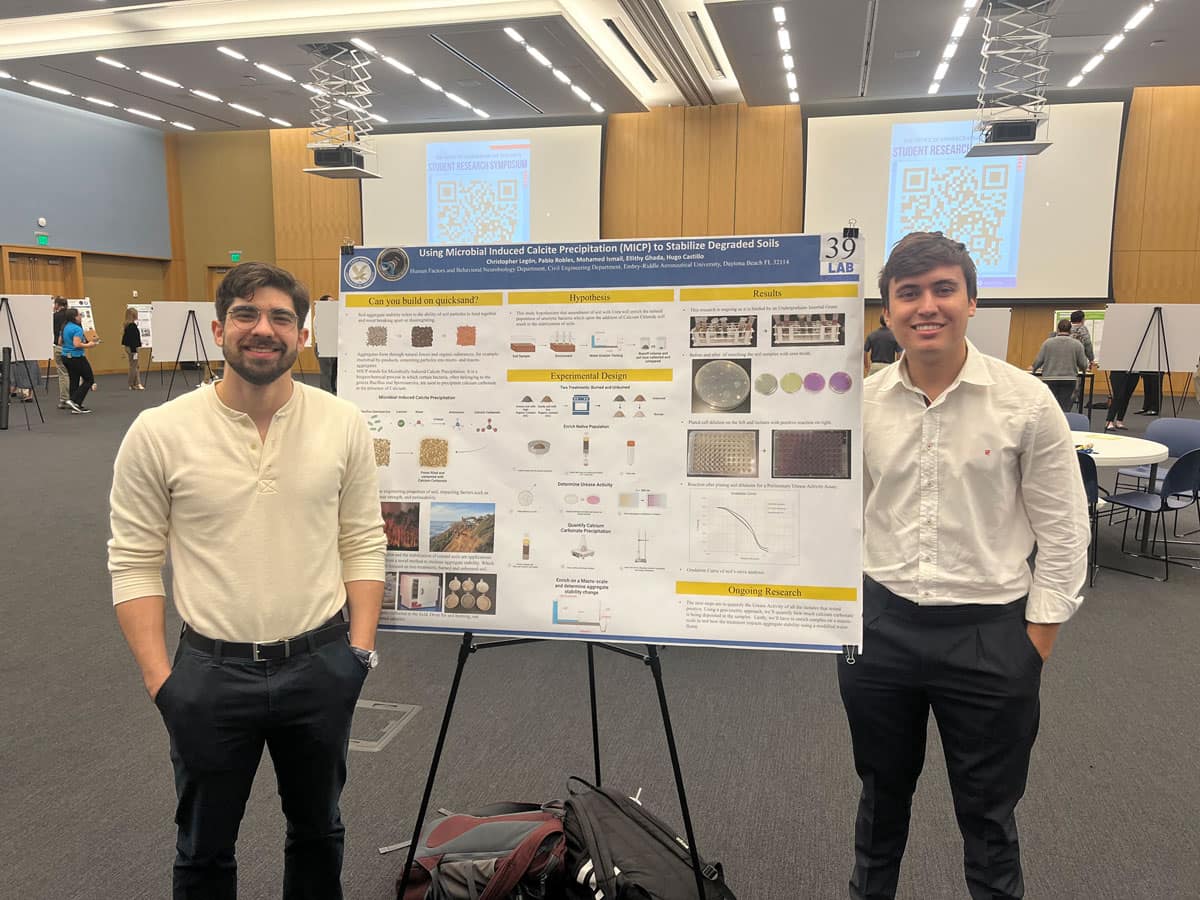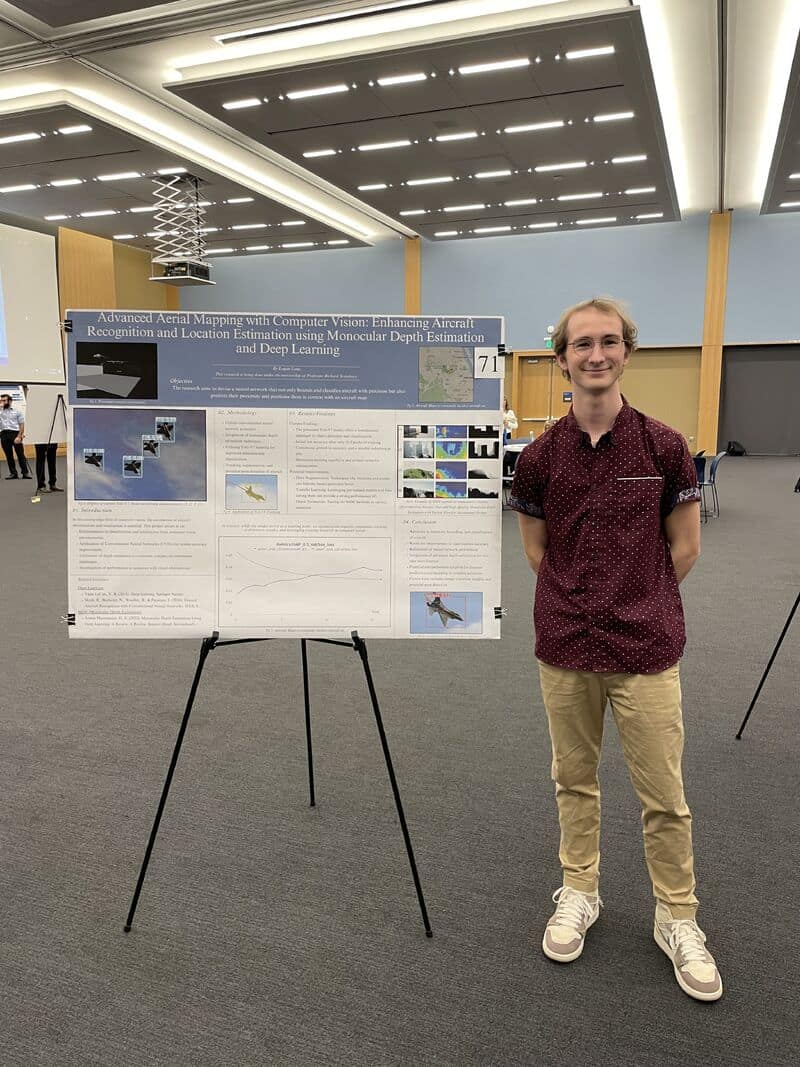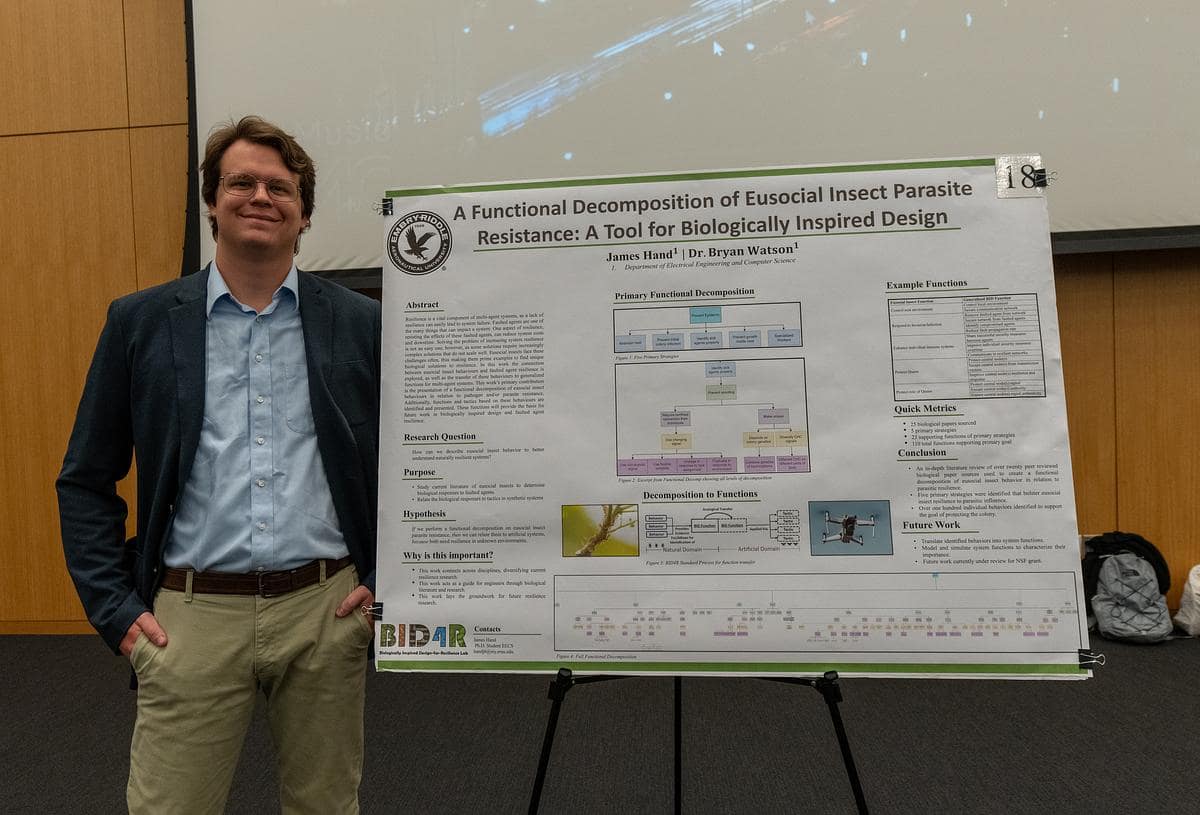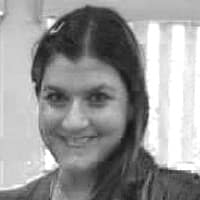Student Research Symposium Features Microbiology, AI and Innovative Design Projects

The winning projects at Embry-Riddle Aeronautical University’s Student Research Symposium explored everything from using microbiology and biologically inspired design in engineering, to examining how computer vision, which is a type of artificial intelligence (AI), could be used as a tool to enhance air traffic control.
The Student Research Symposium, hosted by the Office of Undergraduate Research, featured 78 posters and awarded first-place titles in three categories: two undergraduate posters and one graduate poster. Students were invited from across campus to present their research in the Mori Hosseini Student Union on Embry-Riddle’s Daytona Beach Campus, with more than 400 students, faculty and staff in attendance.
“The vision for this event is to increase the visibility of the students’ research achievement and increase opportunities for collaboration,” said Dr. Ronnie Mack, director of Embry-Riddle’s Office of Undergraduate Research. “We were able to increase the engagement of external stakeholders to the event, which allows students to network with the local community and connect with industry partners.”

Computer Science student Logan Luna also won a first-place undergraduate student session award for his research examining how computer vision, which is a type of artificial intelligence (AI), could be used as a tool to enhance air traffic control. (Photo: Logan Luna)
Using Bacteria to Increase Soil Stability
Aerospace Physiology student Christopher Legon, won first place in one of the undergraduate student sessions for his research looking at a new way to increase soil stability in coastal lands and areas struck by forest fires.
“We’re essentially adding a nutrient soup to soil that will help special bacteria grow then react with a calcium source to release a metabolic byproduct that cements soil particles together and increases soil stability,” said Legon.
Legon worked with Dr. Hugo Castillo, assistant professor in the Department of Human Factors and Behavioral Neurobiology and director of the Space Microbiology Lab, on a different project when Castillo and Dr. Ghada Ellithy, assistant professor in the Civil Engineering Department, introduced him to this topic. Legon collaborated on the proposal with fellow Aerospace Physiology student Pablo Robles and Mohammed Ismail, a graduate Civil Engineering student.
“Microbiology fascinates me, so it was a no-brainer to take this opportunity,” said Legon. “The learning environment Dr. Castillo fosters is remarkable. Everything I know about bacteria and cell theory is thanks to him.”
In addition to helping renourish soil and coastal lands, this research may even have uses beyond Earth, Legon added. Bacteria that release calcium carbonate, which is the cementing agent, is applicable in many areas of study, including in space, he said.
“There are possible implications of using these bacteria to help remove heavy metal ions using calcium carbonate in water purification efforts or potentially grow plants on lunar soil,” said Legon.
Enhancing Air Traffic Control
Computer Science student Logan Luna received the other first-place undergraduate award for his research examining how computer vision, which is a type of AI, impacts advanced aerial mapping. Dr. Richard Stansbury, associate professor of Computer Engineering and Computer Science, was Luna’s advisor on the project.
“The general idea is that you could point a camera toward an aircraft and receive public information regarding the aircraft you are looking at, such as its identification tag and flight path,” said Luna. “My research offers practical tools for air traffic control to track and identify aircraft, enhancing airspace safety and regulatory compliance. This could help in many ways, from managing air traffic more efficiently to enhancing safety in the skies.”
Luna became interested in AI and Machine Learning (ML) after getting involved with the university’s Autonomous Maritime Robotics Association and working on image-detection software for the autonomous submarine. He plans to intern this summer for the Department of Defense, where he will focus on developing detection and tracking systems for laser weapons on naval ships and protecting personnel.
“Long term, I plan to pursue a career in AI Engineering, specifically researching optimization techniques within AI and ML to maximize their effectiveness,” said Luna. “Overall, I want to significantly contribute to the field of AI to positively impact the world.”

James Hand, an Electrical Engineering and Computer Science doctoral student, won first place overall for his graduate poster, which details research on how insect colony behaviors can be used as a tool for engineering. (Photo: Embry-Riddle/David Massey)
James Hand, an Electrical Engineering and Computer Science doctoral student, won first place overall for his graduate poster, which details research on how insect colony behaviors can be used as a tool for engineering. (Photo: Embry-Riddle/David Massey)
How Biology Can Influence Engineering
James Hand, an Electrical Engineering and Computer Science doctoral student, won first place overall for his graduate poster, which details research on how insect colony behaviors can be used as a tool for engineering.
“Ants, bees, termites, etc. have been protecting themselves from a variety of threats, including fungus infections that take over their brains, or invasions from other colonies,” said Hand. “These threats are similar to how robotic systems, computer networks or other systems have to fight off things like cybersecurity threats or sensor degradation.”
Hand said he built on research started by Dr. Bryan Watson, assistant professor of Systems Engineering and director of the university’s Biologically Inspired Design-for-Resilience (BID4R) Lab. Hand’s research examines the behaviors/functions that insects use to improve their resilience, as well as a guideline for how those functions can be applied by humans.
“I have had a chance to work on a variety of work with Dr. Watson, from computer vision tracking of bed bug movements, to millipede swarming behaviors, to this current research,” said Hand. “He has taught me pretty much everything I know about how to do proper research, how to manage and advise undergraduate students, and more.”
Hand earned his master’s in Unmanned and Autonomous Systems Engineering at Embry-Riddle, then decided to pursue his Ph.D. in Electrical Engineering and Computer Science.
“I have always enjoyed interdisciplinary work,” said Hand. “So, getting a chance to mix biology and engineering in a new way is right up my alley.”

 Melanie Stawicki Azam
Melanie Stawicki Azam